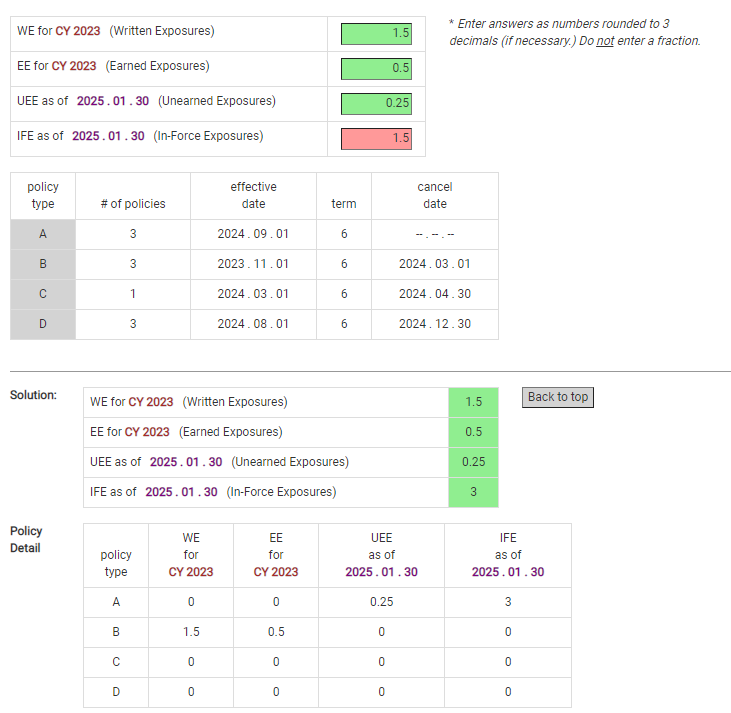Fall 2016 Q1(b) vs Battleacts Calculator regarding Inforce Exposures
Hi,
I found out that the CAS solution for Fall 2016 Q1(b) takes into account of the 6 months term in calculating the in-force exposures, but the Battleacts calculator does not. As shown in the screenshot below, the inforce exposure is calculated by taking the 3 policies for Policy Type A, instead of 3 x 0.5 = 1.5.
May I know whether inforce exposures should consider the 6 months term?
Appreciate your clarification! Thank you.

Comments
Unfortunately, they were trying to trick you here. If the question had asked for in-force exposures (which is usually the way the question is asked) you would not have to take into account the policy term. This is the case for the web-based problem you referenced. The Werner source text states:
But this particular exam problem asked for in-force car-years, rather than in-force exposures. So in this case, you did have to take into account the policy term and multiply the in-force exposures by 0.5 because the policies were all 6-month policies.
Hi Graham,
Thank you for your explanation.
However, the examiner's report states that "Candidates were expected to demonstrate how to calculate in-force exposures for 6-month policies. Common mistakes included: Not taking half of the exposures to account for the 6-month term since exposure is defined as one car-year".
Isn't it the in-force car-years = in-force exposures?
Thank you.
Yes, I see that further down in the examiner's report, they actually say "in-force exposures" even though in the actual question for part (b) they use the term "in-force car-years". Normally 1 written exposure means the same thing as 1 written car-year and the same thing for earned exposures and earned car-years. But Werner defines "in-force" exposure a little differently.
So I think it's either a typo in the examiner's report or it's just plain wrong. If you are an insurer and you have 100 policies in-force, then you could potentially have a claim on all 100 policies at the same time. Werner clearly states it doesn't make any difference whether they are 6 or 12 month policies. I don't think Werner ever refers to in-force "car-years". They refer only to in-force "exposures" That's the whole idea behind the notion of "in-force". (Werner does mention that not all insurers are consistent in this definition but the official definition given disregards the policy term.)
I don't know how to completely resolve this. The examiner's reports do have mistakes in them from time to time and unfortunately they are never corrected. I think if you pay attention to whether the question uses the term in-force "exposures" or in-force "car-years" then that's your signal whether to take into account the policy term. (If "car-years" is used then you should take into account the policy term.)
Thank you so much for your detailed explanation Graham!
In short, can I conclude that - we will ignore the policy term ONLY when the question asked for in-force "Exposures", else need to account for the policy term?
Thanks!
Yup, I believe that should get you through! (It also doesn't hurt to briefly explain your interpretation on the exam. The graders seem to be more forgiving if you explain yourself and show you understand the concepts even if you get a different answer from theirs.)